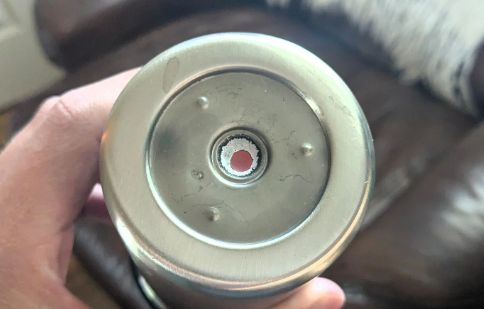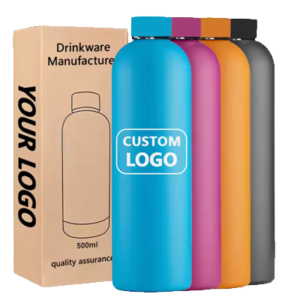Why Lead-Free Bottle Manufacturing Costs Vary?
With growing awareness of health and safety, consumers and the media have increasingly scrutinized vacuum bottle safety and testing results. Thanks to stricter regulatory standards and long-term consumer concerns about health, lead-free water bottles have become a standard requirement for retailers and brands.
But does adopting lead free insulated water bottles increase procurement costs for retail brands compared to traditional sealing methods?
Table of Contents
Toggle1. What Is Lead-Free Bottle Manufacturing?
Lead-free water bottle manufacturing primarily refers to the use of lead-free soldering techniques. Lead-free soldering eliminates lead from the welding process, reducing environmental and health risks compared to traditional lead-based soldering.
By replacing conventional leaded solder with eco-friendly alternatives, this method minimizes potential harm to both the environment and human health. Additionally, lead-free soldering aligns with international environmental regulations, such as the EU’s RoHS directive, making it a more sustainable and compliant choice for brands and vacuum bottle manufacturers.

2. Forms of Lead-Free Soldering and Their Differences
Welding is a pivotal step in manufacturing, as it directly influences the sealing and durability of vacuum bottles. Traditional processes typically use lead-based brazing agents, whereas lead-free techniques substitute these with eco-friendly alternatives. This switch not only cuts down on harmful emissions but also enhances overall product safety and environmental performance.
After the vacuum stage, a brazing agent is applied to fully melt and seal the vent, ensuring a smooth, flawless finish without bubbles or depressions.
However, the choice of solder material leads to two distinct lead-free approaches in the market: one that utilizes glass beads as a brazing agent, and another that employs genuine stainless steel beads.
Stainless Steel Bead Welding
Stainless steel bead welding is considered a more advanced method. Because these beads are made from the same material as the bottle’s inner liner and outer shell, they represent a truly “lead-free” solution that meets rigorous environmental standards.
With a higher melting point and excellent corrosion resistance, stainless steel beads can endure greater mechanical stress and more challenging conditions.
Moreover, this technique leaves behind only a minimal groove, which simplifies the production process and results in a cleaner, more aesthetically pleasing bottom—a key factor for high-end markets.

Glass Bead Soldering
On the other hand, glass bead brazing is widely adopted throughout the vacuum bottle industry. Low-melting-point glass forms a robust joint at relatively lower temperatures and, due to its excellent fluidity and sealing properties, ensures airtight and watertight performance. Its chemical stability also helps maintain long-term durability by preventing adverse reactions with the bottle material.
However, the glass bead process typically creates a more pronounced groove at the bottle’s base. This flaw necessitates the use of an additional stainless steel patch to cover the depression, thereby increasing both production complexity and time costs.
Key Differences Between the Two Forms
The visual differences between these two methods largely stem from the distinct physical properties and flow characteristics of the materials involved. Variations in how the molten solder fills the seam and shrinks upon cooling directly influence the size of the groove.
At present, only few of companies have mastered the precise control required for stainless steel bead welding—fine-tuning laser power, pulse frequency, and other parameters—to significantly reduce this groove. This technical finesse encapsulates the evolutionary leap in lead-free welding technology.
Haers has successfully integrated both lead-free techniques into its production. While the glass bead method remains the industry standard, our breakthroughs in stainless steel bead technology have propelled us into a higher technical echelon. This dual capability not only solidifies our core expertise in lead-free welding but also provides retail brands with a distinct option to set their products apart in terms of bottle design and quality.
3. Which Products Utilize Lead-Free Soldering?
So, vacuum containers such as flasks, tumblers, food jars, beer growlers, and other stainless steel or titanium bottles, can all be made using lead-free technology. For consumers, they just need to read the product description on the brands’ and retailers’ websites to see if there is a “lead-free” tag.
If a product is made lead-free, the retailers must be labeling it clearly, as they paid an extra cost for this.
4. Why Is Lead-Free Soldering Necessary?
In the past, lead-based solder was widely used in manufacturing due to its low cost and excellent welding properties. However, the toxic effects of lead have become increasingly evident—it is difficult to degrade in the natural environment and can enter the human body through the food chain, leading to severe consequences such as neurological damage and developmental issues in children.
As a result, seeking a new way to make safer and non-toxic lead-free bottles has become a shared pursuit among manufacturers and brands.
Lead-free soldering emerged as a solution to this issue. What began as a compliance measure to meet international regulations has now evolved into a proactive innovation, marking a significant step in the transformation and upgrading of the manufacturing sector.
Key Advantages of Lead-Free Soldering:
Environmental and Healthy Friendliness
Lead-free soldering is a more eco-friendly alternative, eliminating the risks associated with lead contamination.
Since lead is a hazardous material that poses long-term threats to both human health and the environment, adopting lead-free processes aligns with global environmental regulations and sustainability trends.
Improved Reliability
Lead-free soldering enhances the durability of welded joints. Traditional lead-based soldering can suffer from reliability issues such as thermal shock cracks and delayed fractures.
The adoption of new soldering materials and techniques in lead-free soldering provides better mechanical strength and long-term reliability. Furthermore, it significantly improves electrical performance by reducing contact resistance, enhancing signal transmission quality, and ensuring greater stability.
Compliance with Safety Standards
As global environmental regulations become more stringent, lead-free soldering has become an industry standard. High-end markets, export-oriented products, and children’s items all demand higher safety standards.
By adopting lead-free technology, brands and retailers can enhance their competitive edge and meet consumer expectations for health-conscious and eco-friendly products.
5. What Is the Lead-Free Soldering Process?
The lead-free soldering process involves several key steps:
Material Preparation: Selecting appropriate lead-free soldering materials that meet both environmental and performance requirements. Traditional vacuum bottle manufacturing relied on lead-based solder for its low melting point and excellent fluidity. The first challenge of lead-free soldering is finding an alternative material that offers similar performance without the associated health risks.
Welding Process: The choice of welding method depends on specific manufacturing needs. Once the welding method is determined, appropriate equipment and process controls must be selected to ensure optimal performance.

Surface Treatment: Depending on the soldering material used, additional steps such as surface polishing or the application of protective patches may be required to enhance smoothness and aesthetic appeal.
Quality Testing: Lead-free soldered products undergo rigorous reliability tests, including airtightness and durability assessments, to ensure they meet the required standards before reaching consumers.
6. Are There Special Equipment Requirements for Lead-Free Bottles?
In vacuum bottle manufacturing, the vacuum brazing furnace is one of the core pieces of equipment for achieving lead-free soldering. Depending on the welding temperature, vacuum brazing furnaces can be categorized into high-temperature and low-temperature types.
These two furnace types differ significantly in material compatibility, process parameters, equipment configuration, and cost structure, which directly impact the effectiveness and economic feasibility of lead-free soldering.
The lead-free soldering process is generally longer than traditional lead-based soldering and requires a higher temperature. This is because lead-free solder has a higher melting point and lower wettability.
Typically, high-temperature brazing furnaces are used for lead-free processes, whereas most conventional welding still relies on low-temperature furnaces. High-temperature vacuum brazing furnaces operate between 800°C and 1200°C, making them suitable for high-melting-point materials such as stainless steel and titanium alloys. Due to their high-temperature capabilities and vacuum environment, these furnaces significantly improve the quality and consistency of welds.
The choice of welding method depends on the specific application. Different components require different welding techniques, and the selected process should match the materials involved.
If the glass bead soldering method is an improvement on traditional welding, then stainless steel bead laser welding is a revolutionary breakthrough. This technique eliminates the need for soldering different materials altogether, fusing stainless steel beads directly with the cup’s base material.
This process precisely controls heat input, minimizing heat-affected zones and reducing structural damage to the cup body. It also allows for seamless welding, creating a near-invisible joint.
However, the technical barrier is high—investments in specialized laser equipment, fine-tuning welding techniques, and precise control over laser power and pulse frequency are all required. This explains why only few of vacuum bottle manufacturers have successfully implemented true stainless steel bead lead-free welding.
7. How Does Lead-Free Soldering Impact Bottle Production Costs?
Overall, adopting lead-free manufacturing processes demands significant upfront investment—in materials, equipment, and research and development. Moreover, the technical differences between using glass beads and stainless steel beads lead to distinct cost structures for each process, making it hard to definitively say which one is more expensive. A thorough, multi-dimensional analysis that considers all factors and the specific circumstances of each company is necessary.
Material Costs
Different soldering materials result in different cost structures:
- Glass beads are relatively cheaper than traditional lead-based solder.
- Stainless steel beads, while more expensive than glass beads, eliminate the need for additional patching, potentially reducing material costs.
- Using glass beads requires additional stamping and welding processes to attach patches, increasing production time and material consumption.
- The complexity of lead-free processes demands ongoing R&D, trial-and-error, and optimization, adding labor and material development costs.
Equipment Costs
Equipment expenses play a crucial role in cost determination:
- High-temperature vacuum brazing furnaces are more expensive than low-temperature ones due to their advanced heating elements and high-vacuum pump systems.
- Maintaining a high-temperature vacuum system adds to operational and maintenance costs, making the total investment significantly higher.
The stainless steel bead process presents an even greater financial challenge:
- Laser welding equipment is extremely expensive, especially imported high-precision models.
- However, in the long run, lower defect rates and higher product consistency reduce quality control costs.
- High-end, lead-free soldering also offers a premium pricing advantage, improving profitability over time.
Due to its technical complexity and precision equipment requirements, the stainless steel bead process has a higher operational cost than the glass bead method. However, its speed, reliability, and reduced manual labor costs make it economically viable in the long term.
Overall, while adopting a lead-free process may drive up production costs in the short term—mainly due to higher equipment investments and increased process complexity, it’s important to see this as a temporary phase. Looking forward, the evolution of lead-free techniques is just beginning.
With the domestic production of laser equipment and ongoing technological advancements, the cost of machinery for stainless steel bead processes is expected to drop over time.
Furthermore, growing demand for lead-free products in the high-end market will likely accelerate the adoption of this method. In both materials and equipment sectors, continuous innovation and scaling up production will gradually lower the per-unit cost.
Beyond cost considerations, the benefits of a lead-free approach—such as improved environmental performance, better health outcomes, and enhanced brand image—offer companies significant market advantages and opportunities for premium pricing.
When lead-free technology transforms from a regulatory necessity into a source of innovation, it represents a broader shift toward sustainable manufacturing. Therefore, despite higher initial investments, embracing lead-free production is set to become an inevitable trend in the insulated cup industry, driven by both technological progress and a deeper commitment to environmental and health values.
8. How Many Factories in China Can Produce Lead-Free Bottles?
Currently, factories capable of lead-free production primarily adopt glass bead soldering, as this technique is widely adopted and technologically mature. Most mid-to-large-scale manufacturers in China’s vacuum bottle industry have the capability to implement glass bead welding.
However, stainless steel bead soldering requires much higher technical expertise and investment, creating a significant entry barrier. As a result, only a few leading brands have adopted this advanced lead-free process—and we are among them.


